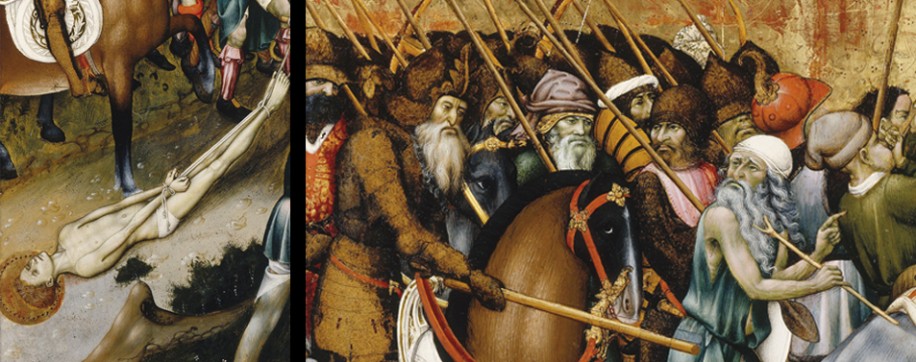Catalunya 1400
The International Gothic Style
The other story of Saint George

Bernat Martorell. Saint George dragged towards the martyrdom
c. 1434-1437.
París, Musée du Louvre, Département des Peintures
© RMN/Daniel Arnaudet
In 1456 it was decided that the feast of Saint George should be celebrated all over Catalonia. Some decades before that, the Deputies of the General (Generalitat de Catalunya) had already adopted this saint and knight as their patron. Saint George was identified with the aristocratic and chivalrous ideal of the time and represented perfectly the ideals of an institution that watched over the proper fulfilment of the laws of Catalonia. In about 1432 to 1434, the deputies built a chapel dedicated to the saint in the Palau de la Generalitat in Barcelona and, around the same time or soon afterwards, they must have commissioned the large retable to preside the altar. This retable is probably the same one that is now kept in fragments scattered between The Art Institute de Chicago and the Musée du Louvre in Paris.
The retable illustrates aspects from the legend of the saint. The central panel, in Chicago, presents the most popular image of this myth, the idealisation of the knight Saint George who kills the dragon to save his princess. In contrast, the side panels to be found today in the Louvre in Paris centre on hagiographic aspects of the saint that are less familiar nowadays, the other side of Saint George, who is not so much a hero as a victim. These four panels therefore depict episodes of the saint’s martyrdom that are almost unknown to the modern public: the Judgement, the Flagellation, Saint George being led to torture and the Beheading. This is the story of a Christian knight from a noble family, who in the 4th century, under the Emperor Diocletian, chose to undergo seven years of torture and die faithful to his religious convictions.
The Palau de la Generalitat and its artists
During the last decades of the 14th century and the first of the 15th, the two buildings that still house the main offices of civil government in Barcelona were either built or remodelled. These were the Casa de la Ciutat, or City Hall, and the Casa de la Diputació del General (Palau de la Generalitat). Taking part in the decoration of these buildings were some of the best artists of the time, such as the sculptor Pere Joan, who made the magnificent medallion with Saint George killing the dragon on the façade of the Palau de la Generalitat overlooking Carrer del Bisbe, and the artist behind the Retable of Saint George in the chapel in the same building. But with the passage of time the memory of these artists was erased and the painter of the Retable of Saint George was for many years relegated to anonymity.
In search of the Master of Saint George
A long path, sown with obstacles, led to the identification of the artist behind this masterpiece of Catalan art. Because the retable had been broken up, the memory of the work as a whole was lost. Five of the panels making up the retable have survived and, having been sold separately, they kept changing hands until one arrived at the Art Institute of Chicago and four at the Musée du Louvre in Paris.
The geographical scattering of the pieces led to different studies, which were undertaken between the end of the 19th century and the 1930s by specialists everywhere. These saw a painter of great worth, to whom they gave the name of Master of Saint George and attributed works of similar quality which were stylistically related but whose origin was unknown. The mystery as to the person behind these works could only be solved with a documentary testimonial providing definite paternity. The enigma was cleared up during the Spanish Civil War, when the contract for the retable of Sant Pere de Púbol, a work by Bernat Martorell in a style close to the Saint George in Chicago, turned up in the archives of Barcelona cathedral. It had taken 57 years of research to answer one of the great mysteries of Catalan painting: Bernat Martorell, the most sought-after painter of his time and who had cornered the best commissions, was undoubtedly the Master of Saint George.
| Artist | Bernat Martorell |
|---|---|
| Title | Saint George dragged towards the martyrdom |
| Date | c. 1434-1437 |
| General classification | Retable |
| Material / Technique | Tempera on oak wood |
| Dimensions | 107 x 35 cm |
| Work conservated in | París, Musée du Louvre, Départament des Peintures |
